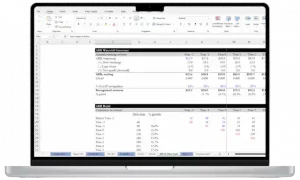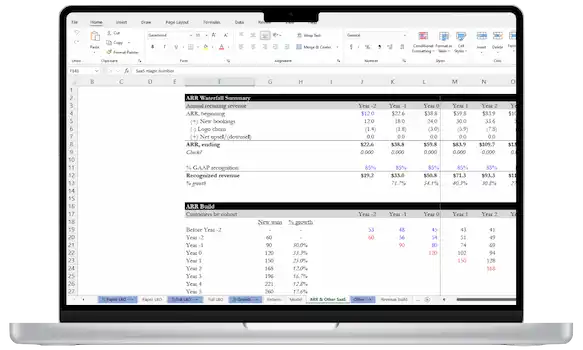What is ACV in SaaS?
Annual contract value (ACV) is a way to calculate the annual value of a multi-year contract. Since recurring annual revenue is the lifeblood of SaaS companies, it is important to know how annually valuable a contract will be.
ACV usually goes alongside total contract value (TCV) as a metric. Both are important ways to assess a customer’s value to the business, but since revenue and financial statements are calculated on an annual basis, it is valuable to have the value of a multi-year contract annualized for financial forecasting purposes.
This is especially important for accurate comparison of contract value for customers with different contract lengths. A customer with a 5-year contract may appear to be more valuable to the company than one with an 18-month contract.
However, over the course of a single year, the customer with the shorter contract may actually contribute more value to the company.
How to calculate ACV
Annual contract value is calculated as follows:
(Total contract value – one time fees)/Contract length = ACV
If desired, you can also calculate ACV as Average Contract Value to look at the value of all contracts averaged and normalized to a year’s time. That would look like this:
Total annual contract value across all contracts/Number of contracts = Average contract value
If you want to see how much value a multi-year contract contributes to the company in a single year, you can use Annual Contract Value. If you want to see how your company’s ACV compares to competitors or industry averages, you can use an average ACV that looks at your contract values across all pricing tiers for your company.
ACV calculation example
Let’s continue our example from earlier. Suppose you had a customer who started a new 5-year contract. The one-year contract cost would be $5,000 per year, but since the contract is for 5 years, you offer a discount of $3,000 off the total cost, for a total of $22,000.
The customer also paid one-time onboarding fees of $625, for a total contract value of $22,625 over 5 years. That would look like this:
($22,625 – $6,255)/5 = $4,400
As we can see here, the company is making slightly less money on this customer per year than they would on a customer that only signed a contract for one year at $5,000.
However, the advantage here is longevity and predictability. You don’t need to spend new marketing dollars on the customer to persuade them to renew their contract every year.
Also, you can count on the recurring revenue when creating a budget plan for the next year. There are far fewer extenuating circumstances (bankruptcy, breach of contract) that will cause a multi-year contract customer to churn than there are reasons for a one-year or monthly subscriber to leave.
Contrast that with a customer who signed an 18-month contract. The one-year contract is for $5,000, with an additional $2,500 for the half-year. There is no discount for a contract less than two years. There is the same onboarding fee of $625, for a total contract value of $8,125. Now the ACV calculation looks like this:
($8,125 – $6251.5)/1.5 = $5,000
Notice that the ACV is higher for shorter-lived contract, which is not uncommon in software plans due to the value of predictability from long-term plans.

- 33 lessons
- 8+ video hours
- Excels & templates
ACV vs ARR
On a single-contract basis, ACV and Annual Recurring Annual Recurring Revenue (ARR) will be very similar.
However, ARR is always an exact amount, while ACV can vary based on different companies’ calculations – some choose to include one-time fees in total contract value, while others do not. Since ARR has an accepted standard calculation, it is used as a size and valuation metric for SaaS companies while ACV is not.
Additionally, ARR is usually calculated on all subscriptions and contracts in total, rather than on an individual basis. ACV is usually calculated on a single-subscription basis. While they serve similar purposes, ACV is more useful as an internal KPI, while ARR is often requested by and useful for internal and external stakeholders.
See here for deeper dive on ARR.
ACV vs TCV (Total contract value)
TCV is essentially part of the ACV calculation. TCV looks at the total value of the contract over its entire lifetime, including non-recurring revenue or one-time fees. ACV is calculated from TCV as shown in the formula above. To get ACV from TCV, you simply have to subtract the one-time fees and divide by the number of years in the lifetime of the contract. You can simplify the ACV formula above as:
(TCV – one time fees)/Years in contract = ACV
ACV vs AOV (Average order value)
Average order value is another valuable sales metric that is similar, but not identical to, ACV. Average order value is similar to annual contract value in that it measures customer value to the organization, but it is different in that it is not annualized.
Orders can, of course, include one-time purchases that are not necessarily subscriptions or contracts. Average order value is a good way for the marketing and sales teams to look at the company’s pricing.
If the average order value is closer to the lowest service price, it is a sign that the customers tend to buy lower-priced packages and the company’s marketing department should look for ways to sell the higher-priced products to increase the average order value.
Alternatively, if the average order price is very low, it could be a sign that it is time to increase prices.
Benchmarks: What is a good ACV for SaaS?
SaaS companies vary so greatly in their pricing that it is not possible to get an industry-wide average for annual contract value.
Some SaaS companies that cater to high-level enterprise clients may have an ACV of $100,000 or more, while others that serve smaller or mid-size businesses may have an average annual contract value of only a few thousand dollars.
SaaS companies that market B2C often only have an ACV of a few hundred dollars (or less).
Rather than looking at ACV as a standalone success metric, it is more useful to look at ACV alongside other metrics, like CAC (customer acquisition cost). If you have a relatively low CAC compared to your ACV, you are in a better place to succeed and maintain client profitability than if you have a high CAC and lower contract value.
On the other hand, a low ACV can also be a sign that you can easily attract paying customers. Having a product that is so good that people are willing to pay money to give it a try can be a huge boost to new SaaS companies, even if the initial paid package is only a few dollars above a free trial.
Next steps
Check out our complete article series on SaaS metrics if you’d like to learn more! Also, if you’d like to go even deeper, reserve your spot in my SaaS metrics and financial modeling online course today!


 SaaS & Growth Metrics
SaaS & Growth Metrics Break Into Growth Equity
Break Into Growth Equity
